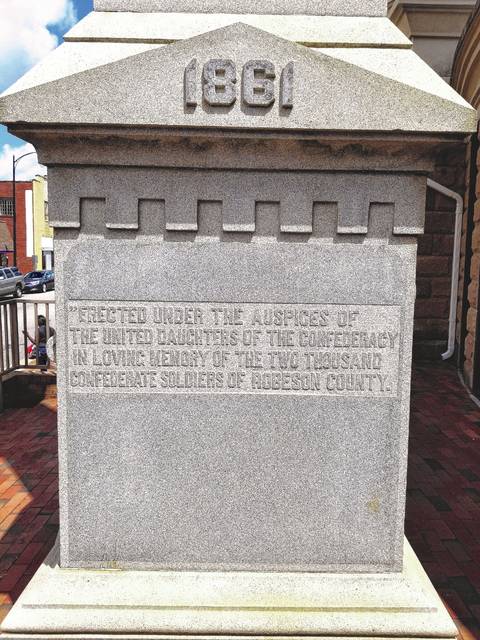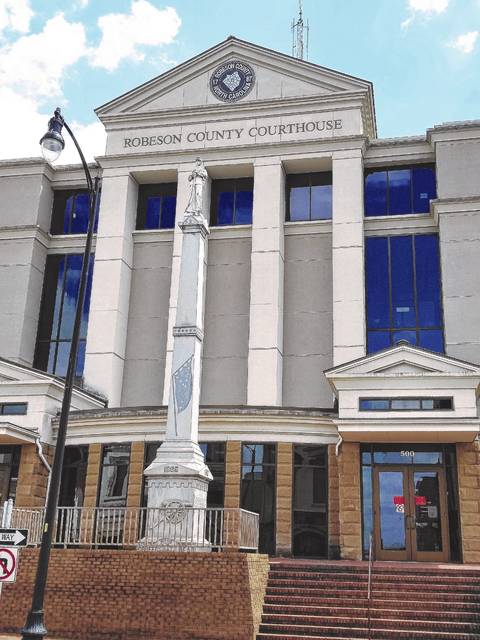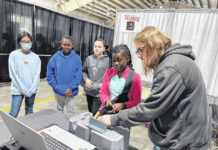LUMBERTON — A bull’s-eye has been placed on a memorial in front of the Robeson County courthouse by Gov. Roy Cooper’s call for the removal from state property all Confederate statues and monuments.
The Democratic governor issued the call Tuesday in the wake of a woman’s death Saturday in Charlottesville, Va., during clashes between white supremacist groups and counter protester at a statue or Confederate Gen. Robert E. Lee. The death in Virginia has sparked accelerated movement across the country to remove Confederate monuments from public view.
Anti-Confederate fervor has cast doubt over the fate of the Robeson County Confederate monument, which rises before the county courthouse. But the removal passion doesn’t appear to grip local residents and government leaders.
When asked Wednesday, people on the street of Lumberton either had no opinion about the monument or viewed it more as a symbol of American history.
“Feels like it symbolizes history and that’s all,” Belinda, a white woman, said as she stood on the courthouse steps.
“I think it looks nice,” said James, a black man.
“In light of the events on Saturday, I take no offense since it represents history,” said Jessica, an American Indian woman.
Opinions about the statue’s fate were more mixed among Robeson County Board of Commissioners members.
Board Chairman Tom Taylor said the statue is part of history and he does not want it to come down. He also referred to the state law that restricts local governments from removing historic monuments from public buildings and grounds without approval from state legislators.
Robeson County Commissioner David Edge made his opinion very clear.
“I’m totally against taking that monument down,” he said.
Taylor and Edge are both white.
Commissioner Jerry Stephens, who is black, said he doesn’t like the statue and what it represents, but he isn’t going to make it an issue. The county’s hands are tied even if commissioners wanted to take it down because of the state law.
He is going to bring the issue up in the future, maybe even at a commissioners meeting, Stephens said.
“I’m not going to fight those who want the monument not taken down if they don’t try to block me from putting up a statue of my choice,” he said. “I’d like to see a statue of Dr. E.B. Turner put up at the courthouse right next to the existing statue.”
Turner, who is dead, is a former county commissioner, a longtime member of the Lumberton City Council, and widely regarded as someone who help keep the peace during desegregation in the county in the late 1960s and early 1970s. He was pastor of First Baptist Church in South Lumberton.
Commissioner Raymond Cummings, an American Indian, said he hasn’t heard anyone talking about the statue at the courthouse.
“There are good arguments on both sides,” he said. “I’m reserving my comments until a later time.”
Taylor said removal of the statue is not up to the governor.
Legislation signed by former Gov. Pat McCory in 2016 prevents the removal, relocation, and alteration of any monuments, memorials, and plaques that reside on public property without the consent of the N.C. Historical Commission. Even if Gov. Cooper were able to get consent from the commission the law still restricts what he can do regarding Confederate monuments. The Confederate monuments are seen as “objects of remembrance” under the law. Therefore they can’t be moved into a museum because the law requires any monument that is moved be placed in an area of similar prominence.
About 200 Civil War memorials, statues, and markers dot the North Carolina landscape. Out of those 200 there are only 54 statues and 20 memorials that specifically honor Confederate soldiers, according to Commemorative Landscapes of North Carolina, a project of the The University of North Carolina at Chapel Hill Library.
The Robeson County Confederate monument, a tall marble obelisk with a soldier at its peak, has stood before the courthouse since it was unveiled on May 10, 1907, to the applause of local residents and Confederate veterans, according to an article in The Robesonian published after the unveiling.
The monument’s inscription, in all capital letters, reads: “1861 / This marble minstrel’s voiceless stone / in deathless song shall tell, / when many a vanished age hath flown / the story of how they fell. / On fame’s eternal camping ground, / their silent tents are spread, / and glory guards with solemn round / the bivouac of the dead.”
On the south face it reads: “Erected under the auspices of / the United Daughters of the Confederacy / in loving memory of the two thousand / Confederate soldiers of Robeson County.”
For more than 110 years the the monument has stood mostly unchallenged until the recent events in Charlottesville, Virginia, and Durham, where a statue honoring Confederate soldiers was toppled by protesters on Monday.
The Confederate soldiers memoralized by the statue were part of the 155,000 North Carolinians who fought in the Civil War, according to historical records found online. Of that number, about 40,000 were killed. No Civil War battles were fought in Robeson County, but a portion of the Union Army led by Gen. William T. Sherman stopped in Lumbeton on March 9, 1865, after his famous March to the Sea.







